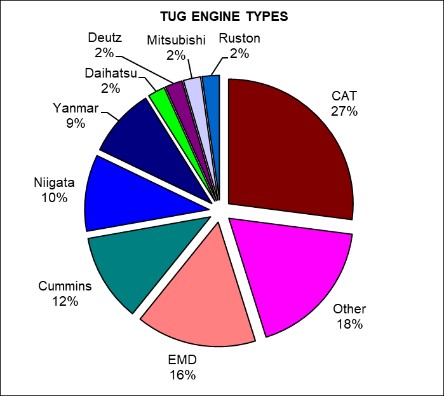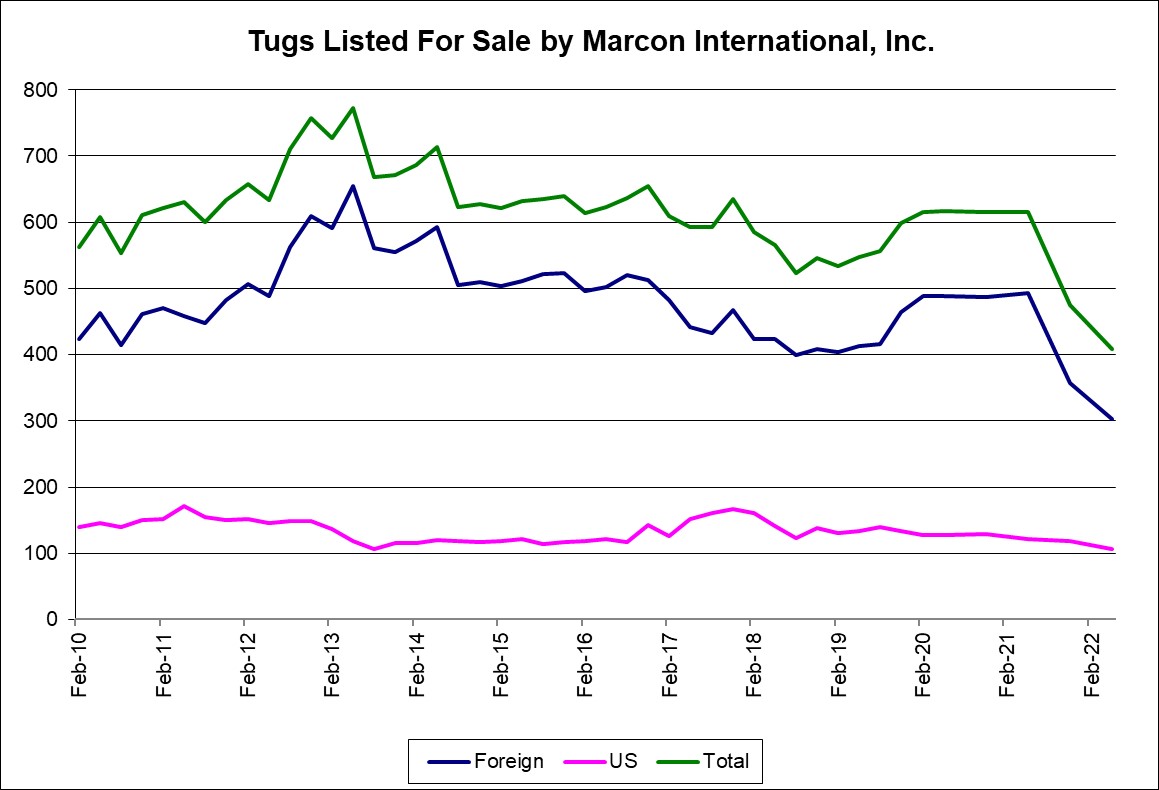Tug Market Report - May 2022
Of the 13,448 vessels and 3,719 barges that Marcon tracked as of May 2022, 5,198 are tugs with 409 officially on the market for sale worldwide, down 66 or 13.89% from one year ago, May 2021, and down 184 or 31.03% from May 2017. 96.26% of U.S. and 43.71% of foreign tugboats for sale are direct from Owners. 81 or 19.80% of the tugs worldwide, primarily foreign flagged, were built within the last 10 years, are newbuilding re-sales or currently under construction â compared to 29.47% one year ago and 30.69% five years ago. 67 (16.38%) are over 50 years of age. Eleven have no age listed. The oldest tug Marcon currently has listed is a 122' LOA, 1,950BHP single screw tug located on the U.S. Great Lakes. This "old lady" is balanced by four newbuildings between 1,490BHP and 4,400BHP scheduled for delivery in 2021. Two newbuildings are azimuthing for delivery to the Far East and Mediterranean, with the remaining two traditional twin screw tugs for delivery to the U.S. and Southeast Asia.
Marcon's Market Comments
 The majority of tugs Marcon tracks for sale as of this report are in the US with 106 tugs officially on the market (vs. 125 one year ago), followed by 71 in Southeast Asia (118), 53 in Europe (64), 52 in the Far East (65), 33 in the Mediterranean (74), 29 in Latin America (43), 17 in the South Pacific (21), Mid-East with 15 (59), 11 in the Caribbean (16), 10 where location unstated (12), 7 in Canada (6) and 5 in Africa (11). Where machinery is known, CAT diesels power 109 or 27% of the tugs listed for sale. This is followed by 63 vessels with EMDs, 46 Cummins, 40 Niigata, 36 Yanmar and 9 each with Daihatsu, Deutz, Mitsubishi and Ruston. 73 tugs are powered by other machinery from Akasaka to Wartsila with one Fairbanks Morse tug on the market.
The majority of tugs Marcon tracks for sale as of this report are in the US with 106 tugs officially on the market (vs. 125 one year ago), followed by 71 in Southeast Asia (118), 53 in Europe (64), 52 in the Far East (65), 33 in the Mediterranean (74), 29 in Latin America (43), 17 in the South Pacific (21), Mid-East with 15 (59), 11 in the Caribbean (16), 10 where location unstated (12), 7 in Canada (6) and 5 in Africa (11). Where machinery is known, CAT diesels power 109 or 27% of the tugs listed for sale. This is followed by 63 vessels with EMDs, 46 Cummins, 40 Niigata, 36 Yanmar and 9 each with Daihatsu, Deutz, Mitsubishi and Ruston. 73 tugs are powered by other machinery from Akasaka to Wartsila with one Fairbanks Morse tug on the market.
 Five years ago, 30.69% of tugs for sale worldwide, primarily foreign flag, were built within the previous 10 years compared to 19.80% today. Then 11.97% of the tugs on the market were 50+ years old compared to 16.38% today. At that time, Marcon had two tugs older than 75 years compared to six today. The average age of all tugs that Marcon has for sale worldwide today is 30 years, with 1992 average build date, compared to 27 years, 1990 average built, in May 2017. The U.S. had the largest selection of tugs listed in 2017 with 150 available (25.3%), followed by 124 in Southeast Asia (20.9%), 65 in Europe (11.0%), 58 in the Mid East (9.8%), Far East 50 (8.4%), Mediterranean 35 (5.9%), 26 in the South Pacific (4.4%), 25 in Latin America (4.2%), 16 Africa (2.7%), 15 Canada (2.5%), 14 in the Caribbean (2.4%), 9 where location is unknown (1.5%) and 6 in Southwest Asia (1.0%).
Five years ago, 30.69% of tugs for sale worldwide, primarily foreign flag, were built within the previous 10 years compared to 19.80% today. Then 11.97% of the tugs on the market were 50+ years old compared to 16.38% today. At that time, Marcon had two tugs older than 75 years compared to six today. The average age of all tugs that Marcon has for sale worldwide today is 30 years, with 1992 average build date, compared to 27 years, 1990 average built, in May 2017. The U.S. had the largest selection of tugs listed in 2017 with 150 available (25.3%), followed by 124 in Southeast Asia (20.9%), 65 in Europe (11.0%), 58 in the Mid East (9.8%), Far East 50 (8.4%), Mediterranean 35 (5.9%), 26 in the South Pacific (4.4%), 25 in Latin America (4.2%), 16 Africa (2.7%), 15 Canada (2.5%), 14 in the Caribbean (2.4%), 9 where location is unknown (1.5%) and 6 in Southwest Asia (1.0%).
Looking at tugs for sale worldwide, conventional twin screw tugs lead with 258 (63.1%) available, followed by 90 azimuthing (22.0%), 43 single-screw (10.5%), 13 Voith Schneider tractors (3.2%) and 5 triple screw (1.2%). This is fairly comparable to five years ago when 15.5% of the 593 tugs for sale were single screw, 60.0% twin screw, 21.4% azimuthing, 2.5% VS tractor and 0.5% triple screw tugs. Bearing in mind that we are focusing on those available for sale, it seems that for the past five years, azimuthing and conventional twin screw tugs have maintained steady positions in the market. Single screw tugs are mostly relegated to nearly zero commercial work, except in certain specific cases. Available for sale units have dropped considerably with many of those being scrapped due to age and condition. It is noted that in mid-May 2022, Sea-Web reported 2,134 tugs worldwide scuttled, broken up or to be broken up world-wide. This is up 34.38% from May 2021's 1,588. Prior reports tracked the scrapping at around 3%, so this confirms our observations that many companies continue to aggressively scrap excessive tonnage amidst the economic fallout of the COVID 19 pandemic in various sectors of the market.
Marcon's database shows 184 fewer tugs officially for sale than five years ago in May 2017 with largest shifts in the lower horsepower categories. There are 51 fewer tugs are today listed in the 3-4,000HP range with average age increasing from 24 to 29 years. The 2-3,000HP range lost 41 tugs while their average age increased from 28 to 34 years. 29 fewer tugs are listed in the 1-2,000HP range, with average age increasing from 29 to 33 years old. The 4-5,000HP range decreased by 26 tugs with average age rising from 20 to 21 years. There are 22 fewer 5-6,000HP tugs with average age increasing from 16 to 25 years now. The under 1,000HP tugs category decreased by 13 with a five year decrease in age to 36 years. There were minor changes in the higher horsepower ranges as far as number available for sale and average age. In summary, we saw a 31.03% drop in listings, all in the under 6,000HP ranges and average age overall increased by three years.
Marcon has closed ten sales to date in 2022 and we have several additional sales pending. This aligns with positive sentiment overall. Activity has nearly doubled compared to 2021 (our worst year ever) and it seems we have finally broken out of the Covid-19 overhang. Operating tugs and barges are in short supply both in the US and international market. Across the age spectrum, the lack of inventory on the second-hand market is our biggest challenge as brokers. Inquiries have steadily increased, especially for ocean deck barges. The rise in diesel prices has refocused buyers on fuel efficiency, creating greater demand for lower BHP "right-sized" tugs. Gone are the days of buying or chartering a 6,000BHP tug to do a job that a 4,000BHP tug can do. Inflation in general has driven up prices to maintain and reactivate tugs and barges, driving the prices of units with current certificates higher. We have also seen several examples of engine and other part shortages, pushing some buyers away from taking on laid-up vessels. Higher oil prices have driven marginal demand for offshore towing and barges, hitting an already tight market. Anticipation of wind projects has several owners holding onto various currently under-utilized tugs and barges. Although there is no way to predict the future, it seems we have at least a few decent years ahead, just getting caught up from the work delayed during the pandemic.
Commercial Marine Brokers since 1981